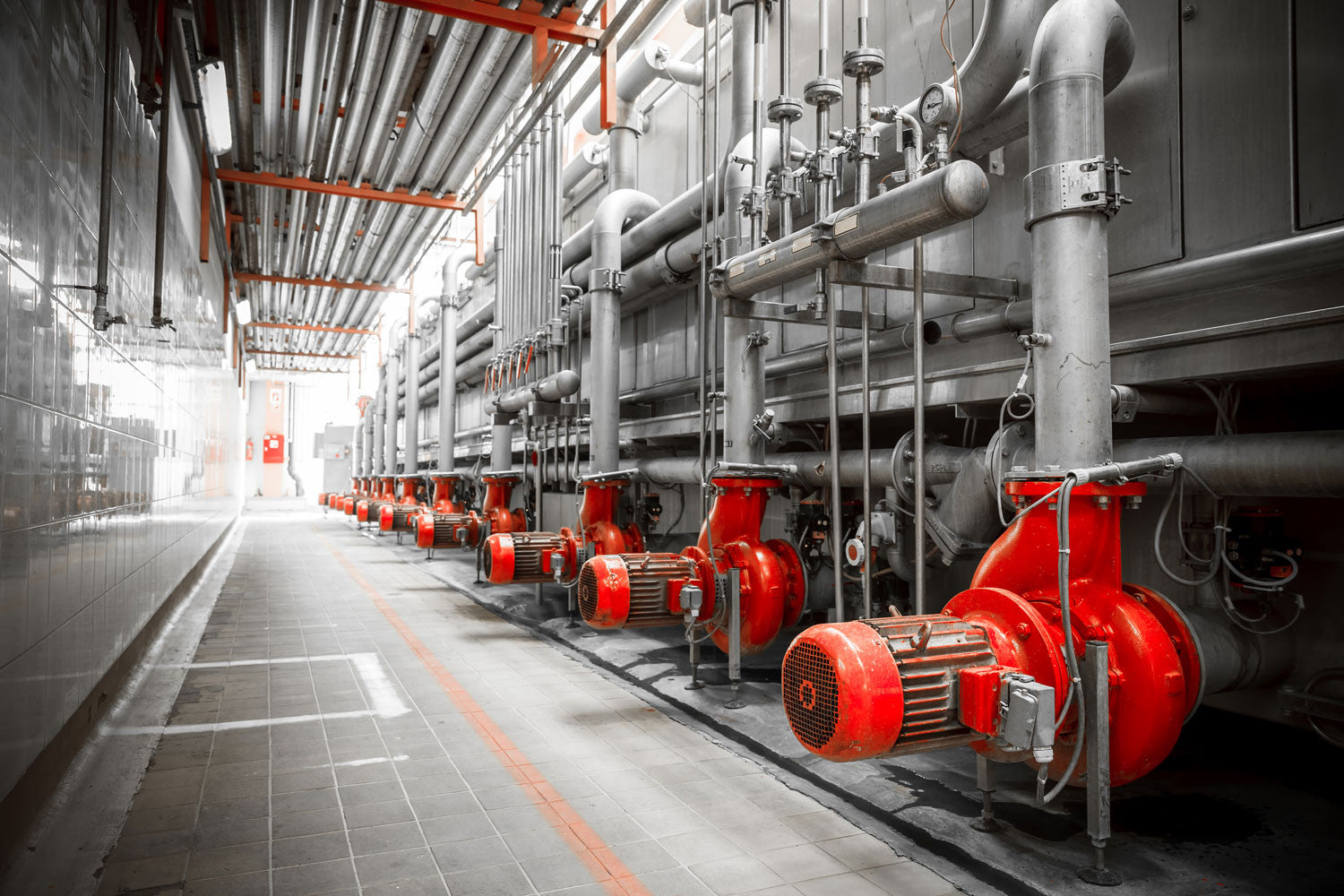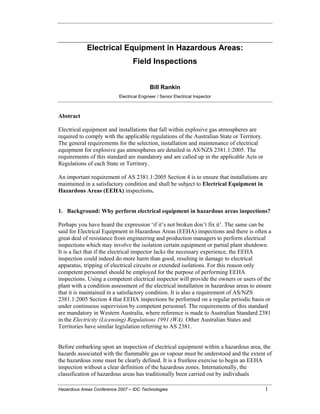An Unbiased View of Roar Solutions
An Unbiased View of Roar Solutions
Blog Article
Getting The Roar Solutions To Work
Table of ContentsThe Roar Solutions DiariesTop Guidelines Of Roar SolutionsThe Buzz on Roar Solutions
In such an ambience a fire or surge is possible when three basic conditions are met. This is usually described as the "harmful area" or "burning" triangular. In order to protect setups from a potential explosion an approach of evaluating and categorizing a potentially unsafe location is required. The purpose of this is to make certain the proper option and setup of equipment to ultimately protect against a surge and to make certain safety and security of life.
(https://pastebin.com/u/roarsolutions)
No equipment must be installed where the surface temperature of the tools is above the ignition temperature level of the provided threat. Below are some usual dirt harmful and their minimum ignition temperature level. Coal Dust 380C 225C Polythene 420C (melts) Methyl Cellulose 420C 320C Starch 460C 435C Flour 490C 340C Sugar 490C 460C Grain Dirt 510C 300C Phenolic Resin 530C > 450C Aluminium 590C > 450C PVC 700C > 450C Soot 810C 570C The chance of the threat being present in a concentration high enough to cause an ignition will differ from place to place.
In order to identify this danger an installation is divided right into locations of danger depending upon the amount of time the dangerous is present. These areas are described as Areas. For gases and vapours and dirts and fibres there are three zones. Area 0 Area 20 An unsafe atmosphere is very most likely to be present and may exist for lengthy durations of time (> 1000 hours annually) or even continuously Area 1 Area 21 A harmful environment is possible but not likely to be present for extended periods of time (> 10 450 C [842 F] A classification of T6 means the minimal ignition temperature level is > 85 C [185 F] Harmful area electric devices maybe designed for use in higher ambient temperature levels. This would suggested on the rating plate e.g. EExe II C T3 Ta + 60C( This means at 60C ambient T3 will certainly not be exceeded) T1 T1, T2, T3, T4, T5, T6 T2 T2, T3, T4, T5, T6 T3 T3, T4, T5, T6 T4 T4, T5, T6 T5 T5, T6 T6 T6 A T Class ranking of T1 indicates the maximum surface area temperature created by the tool at 40 C is 450 C. Assuming the linked T Class and Temperature level score for the equipment are ideal for the area, you can constantly utilize an instrument with an extra rigid Division ranking than needed for the location. There isn't a clear answer to this inquiry. It really does rely on the type of tools and what repair services need to be accomplished. Equipment with specific test procedures that can't be done in the area in order to achieve/maintain third event rating. Must come back to the manufacturing facility if it is before the devices's solution. Field Repair By Authorised Worker: Complex screening may not be required nevertheless details procedures may require to be followed in order for the equipment to keep its third event rating. Authorized personnel should be employed to carry out the job appropriately Repair work have to be a like for like replacement. New component should be taken into consideration as a straight replacement needing no unique screening of the tools after the repair work is total. Each tool with a hazardous score ought to be evaluated independently. These are laid out at a high level listed below, however, for more thorough information, please refer directly to the standards.
The Best Guide To Roar Solutions
The equipment register is a comprehensive data source of equipment documents that includes a minimum collection of fields to recognize each item's area, technological parameters, Ex lover category, age, and environmental data. This details is critical for tracking and taking care of the equipment properly within dangerous locations. In contrast, for routine or RBI sampling examinations, the grade will certainly be a combination of Detailed and Close inspections. The ratio of In-depth to Close examinations will be determined by the Devices Threat, which is assessed based on ignition threat (the likelihood of a source of ignition versus the likelihood of a flammable environment )and the harmful location classification
( Zone 0, 1, or 2). This variant will also affect the resourcing needs for work preparation. When Whole lots are specified, you can establish tasting strategies based on the example dimension of each Great deal, which refers to the variety of random tools items to be checked. To figure out the required sample size, 2 facets require to be evaluated: the size of the Great deal and the group of assessment, which indicates the level of initiative that ought to be applied( reduced, typical, or raised )to the evaluation of the Great deal. By integrating the classification of evaluation with the Great deal size, you can you could try this out then establish the appropriate rejection criteria for a sample, meaning the allowable number of defective products discovered within that example. For even more details on this process, please describe the Power Institute Guidelines. The IEC 60079 typical advises that the optimum period between evaluations ought to not exceed three years. EEHA inspections will additionally be conducted beyond RBI campaigns as part of set up upkeep and devices overhauls or repair services. These examinations can be attributed toward the RBI sample sizes within the influenced Great deals. EEHA examinations are conducted to identify mistakes in electric equipment. A heavy scoring system is important, as a single tool may have multiple mistakes, each with varying degrees of ignition danger. If the consolidated rating of both examinations is much less than twice the fault rating, the Whole lot is deemed appropriate. If the Lot is still considered unacceptable, it has to go through a full evaluation or justification, which might trigger stricter inspection methods. Accepted Great deal: The reasons of any type of faults are determined. If a typical failure mode is discovered, extra equipment might call for evaluation and repair work. Mistakes are classified by seriousness( Security, Integrity, Housekeeping ), making certain that immediate problems are assessed and attended to without delay to alleviate any kind of influence on safety and security or operations. The EEHA database ought to track and videotape the lifecycle of faults together with the rehabilitative activities taken. Applying a robust Risk-Based Assessment( RBI )approach is essential for making sure conformity and safety in managing Electrical Devices in Hazardous Areas( EEHA) (eeha courses). Automated Fault Scoring and Lifecycle Administration: Effortlessly handle faults and track their lifecycle to improve examination accuracy. The intro of this assistance for risk-based inspection even more reinforces Inspectivity's position as a best-in-class solution for regulatory conformity, along with for any kind of asset-centric examination usage situation. If you want discovering more, we invite you to request a demonstration and discover how our solution can change your EEHA administration procedures.
What Does Roar Solutions Mean?

In regards to explosive risk, a dangerous area is an atmosphere in which an eruptive atmosphere exists (or might be expected to be present) in amounts that need unique safety measures for the building, setup and usage of devices. electrical refresher course. In this article we explore the obstacles encountered in the work environment, the risk control measures, and the called for expertises to work securely
These compounds can, in particular conditions, develop eruptive environments and these can have significant and heartbreaking repercussions. Many of us are familiar with the fire triangular get rid of any type of one of the three components and the fire can not happen, yet what does this mean in the context of hazardous areas?
In a lot of circumstances, we can do little about the degrees of oxygen airborne, yet we can have considerable influence on sources of ignition, for instance electric tools. Hazardous locations are documented on the dangerous area classification illustration and are determined on-site by the triangular "EX LOVER" indication. Right here, amongst other essential info, zones are split into three types depending upon the hazard, the likelihood and period that an eruptive ambience will certainly exist; Zone 0 or 20 is deemed the most hazardous and Area 2 or 22 is regarded the least.
Report this page